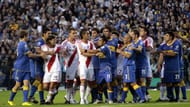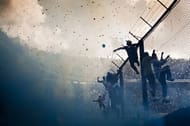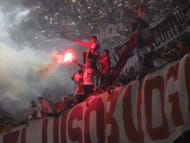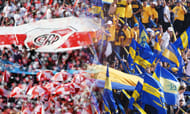Football is a passionate sport. It lifts you up or drags you down. It excites you, makes you cry, angers you and gives such joy that nothing else can bring. For many it’s the highlight of their lives, where they can get out of their mundane, routine lives and for 90 minutes, exalt in the passion of the beautiful game. For the duration of the game, they become more. They are transported from their stifling jobs and dull routines and brought onto the fever of the pitch. For that match, they’re not ordinary people living ordinary lives; they become an army, supporters of their heroes and the temple that is their club.
However, to see the epitome of football passion, one needs to make a pilgrimage to Buenos Aires in Argentina to make it in time for the Superclásico, a derby like none other. The Superclásico is the derby match between Argentina’s two biggest clubs, River plate and Boca Juniors, both based in Buenos Aires. You must be thinking, ‘but there are so many other big derbies, that too played by bigger teams. What makes this one so special?’
Well, unlike other derbies, this isn’t just a match between two clubs from the same city and the fans that live there and support their team. This is a match where the whole country of Argentina, not just Buenos Aires is split between River Plate and Boca Juniors as more than 70% of Argentina support either of the two clubs. This is rivalry at the next level, with much pride and joy taken by the winning team, while the losers, heads down and tails between their legs, walk home in embarrassment.
The rivalry dates long back since the inception of these clubs. The two clubs were both founded in La Boca, the working class dockland area of Buenos Aires, with River being founded in 1901 and Boca in 1905. However, River Plate moved to the prosperous district of in the north of the city in 1925 and ever since then Boca Juniors have laid claim to La Boca, for they stayed back and have branded River as traitors who moved on riches. In the early years of this rivalry, it basically boiled down to a battle of the classes, between the rich affluent people of Núñez and the working class people of La Boca; the Millionaires versus the People’s club. Boca fans are actually known as Xeneizes (Genoese) in reference to Genoa in Italy as many Boca fans come from the local Italian immigrant community. River Plate, on the other hand, became known as, Los Millonarios (The Millionaires), as they supposedly had an upper-class support base. Although, this situation is of the past and now both clubs have supporters from all social classes, it still shows how deep rooted this rivalry is.
The Superclásico is particularly famous for the atmosphere that surrounds it. It’s hard not to feel it, be it that you are a player, a fan, the manager, a grounds-man, a policeman trying to hold the crowd back or whether you are the Barra Brava itself; all can feel the passion on the pitch. Whether the match is being played at Boca's La Bombonera or River's El Monumental, the stadiums turn into a sea of colorful flowing banners, screams and roars, chants, dances and never-ending fireworks. Games have been stopped several times when the crowds go out control. There are fire-hoses kept on the roof to extinguish fireworks that go out of hand. Firemen are seen running around, hosing people down as they try to climb over the cage fences that enclose them. If it weren’t for the football pitch at the middle, you would think that it’s a violent protest against over-bearing governments.
There have been many cases of violence between the two clubs, but, recently the footballing association of Argentina has been coming down hard on cases of hooliganism, so violence has reduced, even if it’s not disappeared. Nonetheless the rivalry is just as high and does not look like it’s going to cool down any sooner. Fans have chants for the opponent teams, ridiculing them. Boca fan’s even go to the extent of calling River Plate ‘chickens’ for choking in big games. River fans reply by calling Boca ‘los chanchitos’ meaning little pigs as they claim that their stadium, located in the La Boca area, smells most of the time, as well as ‘bosteros’ or manure collectors, another reference to the smell of a polluted river in La Boca.
River Plate and Boca Juniors: Head-to-Head
| Tournaments | Games played | Boca wins | Draws | River wins |
|---|---|---|---|---|
| First Division Prof. Era | 202 | 73 | 62 | 67 |
| Copa Libertadores | 22 | 10 | 6 | 6 |
| Supercopa | 2 | 0 | 2 | 0 |
| Copa Competencia | 3 | 0 | 1 | 2 |
| Torneo Centenario | 2 | 0 | 1 | 1 |
| Copa Adrián Escobar | 1 | 0 | 1 | 0 |
| Copa Competencia Británica | 1 | 1 | 0 | 0 |
| Total | 233 | 84 | 73 | 76 |
And it’s not just the fans, even the players, beside their football, rub salt to the wound to incite their rivals even more. That beast of a striker, Carlos Tevez was a Boca legend and he was once red-carded in a Superclásico after he celebrated his goal with a chicken dance, angering the rival fans. After the match, Tevez said that the passion got the better of him. Not wanting to be lesser than their rivals, River player Matias Almeyda was charged with assault and inciting violence after kissing the River badge in front of Boca fans.
Starting from 1913, with a 2-1 victory for River Plate, the two cross-city rivals have met more than 200 times, out of which, Boca have won the majority of the matches, although not by any large margin. All the Superclásicos are considered special and is always highly entertaining; a definite must on any sportsperson bucket list. Many say that Latin America has some of the most passionate football fans in the world. Passionate sounds like an understatement when actually at a Superclásico. It’s not passion; it is a fever, a madness that comes over you.




